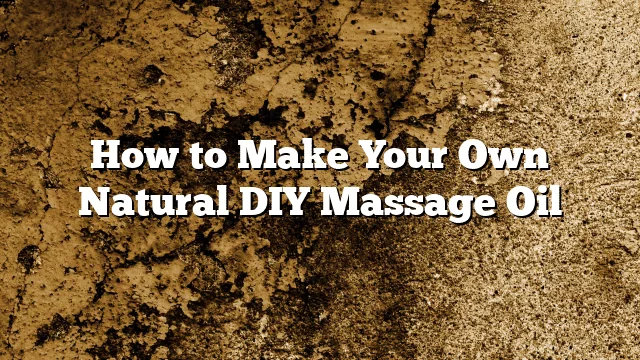
Massage can be an amazing way to ease tension, relax muscles and soften skin. Try this DIY body massage oil recipe made from carrier oil and essential oils for an invigorating or soothing massage experience.
This recipe is simple and affordable, making it perfect for any special event or mood – not only is it great as an affordable Valentines gift idea!
1. Essential Oils
Finding a delicious massage oil recipe starts with selecting essential and carrier oils from plant sources, specifically essential oils from essential plants containing beneficial compounds that must be diluted to reach skin surface application. Carrier oils come from seeds, kernels, nuts or fruits of various trees or plants and need not be extracted separately as essentials can become too potent on their own for application directly onto skin surface.
Carriers oils are highly moisturizing, and work to help deliver essential oil benefits directly to the skin during massage therapy sessions. When selecting carrier and essential oils for use during massage therapy sessions, keep in mind your goals for the session and desired mood – certain essential and carrier oils have different impacts on our bodies and emotions.
Make your own natural DIY massage oil using essential and carrier oils from Moringa seed oil to Jojoba oil to Avocado and Argan oils – plus any combination thereof for an entirely unique massage oil recipe! You have many choices when creating your massage oil recipe from scratch!
Consider any sensitivities or allergies when selecting your oil blend. For instance, if coconut oil causes allergic reactions for you, sweet almond or apricot kernel oils could be better alternatives.
Before adding essential oils to carrier oils, it’s a smart move to first conduct a test mix on fabric or cotton ball to make sure you like its ratios. For instance, when creating blends like eucalyptus, geranium and ylang ylang essential oils blends, just drizzle a few drops from each essential oil onto cotton ball so you can see how they blend.
Once you’ve tested and perfected the fragrance and dilution of your massage oil, add essential oils to a bottle of carrier oil and shake well before storing in a cool dark area for use when needed! For an extra special gift idea consider finding adorable glass bottles to present the massage oil.
2. Carrier Oils
Essential oils can be powerful tools, but should always be combined with a carrier oil for maximum effect. Carrier oils are plant-based oils used to dilute and carry essential oils directly onto the skin. Carrier oils also help protect and moisturize skin while holding on to the aroma from your selected essential oil blends in your massage oil blend.
There is a range of carrier oils to select from, each offering their own special qualities and benefits. Plant based oils offer plenty of variety as choices to use as carrier oil when creating DIY massage oil recipes.
Jojoba oil is an ideal choice because it closely mirrors the natural oils produced by your body and easily absorbed. Furthermore, it replenishes oils stripped from your skin due to soaps, shampoos, or other body care products. Sweet almond oil is another popular pick as it is rich with essential vitamins and minerals beneficial for the skin that are easy to absorb – perfect for both dry skin conditions as well as sensitive ones!
Avocado oil is filled with vitamins and minerals that are great for moisturizing dry, damaged, or ageing skin. As it blends easily with other carrier oils and essential oils, finding avocado oil may take more effort but the effort will pay off because its benefits to skin health outweigh its difficulty of access.
Your best bet for creating a tailored aromatherapy blend is to experiment with various essential and carrier oils in combination. Just remember to test any new combination on a small patch of skin first to check for allergic reactions.
Lavender, chamomile roman and frankincense are known for their relaxing aromas that work wonders to ease tension and stress relief, making a therapeutic massage session all the more soothing. On the other hand, ylang ylang, clary sage and peppermint can energize and revitalize the body; finding your ideal combination can help relax, revitalize, and heal!
3. Vitamin E
Massage can be an incredible way to unwind and relax, providing relief from pain, stress, and poor sleep quality. But you don’t need to spend thousands at the spa to reap its many advantages – instead try making your own natural homemade massage oil at home using just a few simple ingredients!
This DIY coconut oil massage recipe uses lavender and peppermint essential oils, both known for their soothing and invigorating properties. However, you can experiment with other essential oil blends according to your individual needs and preferences; for instance chamomile essential oil may help alleviate anxiety while ylang ylang’s soothing qualities may encourage relaxation.
Vitamin E is another key component in this DIY massage oil recipe, as its anti-oxidative properties help extend its shelf life and keep it smelling fresher for much longer than store-bought massage oils.
Vitamin E oil can be found at most health food stores or online. There are different kinds of Vitamin E oil available; select one intended for cosmetic use if unsure. Alternatively, consult an expert or read labels carefully in order to select an oil suitable for creating DIY massage oil recipes.
Once you have combined your essential oil and carrier oil of choice with vitamin E oil, combine thoroughly before pouring it into a glass jar or other storage container and keeping in a cool, dark location for up to six months.
Before using any mixture on your skin or hair, always conduct a small patch test first to make sure it works as intended. A quick way of testing this would be dripping a small drop of oil on a cotton ball for 24 hours then checking back for signs of irritation or allergic reaction.
Make this DIY massage oil recipe your next relaxing treat when it’s time for yourself or loved ones to unwind! Double or triple it according to your needs and store in the fridge to extend its shelf life. Enjoy using it yourself or gifting a relaxing experience to someone special!
4. Storage
Body massages are an excellent self-care ritual, but professional ones can be costly. Luckily, there are affordable DIY massage oil blends you can make at home to meet all of your needs – be it aromatherapy or therapeutic for specific aches and pains – using just two ingredients and an amber glass bottle – creating your custom body massage oil recipe takes just minutes and can last over one year!
When crafting homemade massage oil, the key to successful preparation lies in using high-grade essential and carrier oils of superior quality. Furthermore, keep in mind that most essential oils need to be diluted prior to their use for safety; using undiluted essentials may cause skin irritation as well as quickly oxidize massage oils quickly if undiluted dilution rates are not strictly adhered to – stick to following these dilution rates by only adding small drops at a time from essential oil bottles.
Carrier oils should be stored in an amber glass bottle that will protect them from light and oxygen exposure, providing easy application via dropper/funnel with label identification for easier identification of ingredients. A cool dark location will help extend its shelf life further.
Fractionated coconut oil is by far the most popular carrier oil when creating DIY massage oil, due to its liquid state at room temperature, low comedogenic rating (meaning no clogging of pores), and lack of an odor – making it the ideal ingredient for DIY massage oil recipes. Jojoba oil also comes highly recommended since its wax structure mimics what the body naturally produces while easily absorbing into skin layers; avocado and grape seed oils may provide additional nourishment or help reverse signs of aging as alternatives.
Once you’ve selected your carrier oil, adding essential oil is simple – all it takes is adding desired amounts to your bottle and mixing well to combine. You can test out the scent of your DIY massage oil by pouring some drops onto your hand and sniffing to determine whether or not its blend meets your criteria.
